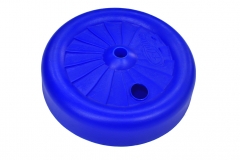What are the forming methods of hollow blow molding equipment?
The production principle of hollow blow molding equipment and its molding method The so-called blow molding machine is also called a hollow blow molding machine. The plastic is melted and quantitatively extruded in the screw extruder, and then formed through the oral film, and then cooled by the air ring, and then blown into the mold. A fast-growing plastics processing method. The tubular plastic parison obtained by extrusion or injection molding of thermoplastic resin is placed in a split mold while it is hot (or heated to a softened state), and compressed air is introduced into the parison immediately after closing the mold to blow the plastic parison. It expands and sticks closely to the inner wall of the mold, and after cooling and demoulding, various hollow products are obtained.

The blow molding machine/process began to be used to produce low density polyethylene vials during World War II. In the late 1950s, with the birth of high-density polyethylene and the development of blow molding machines, the technology of blow molding machines was widely used. The volume of hollow containers can reach thousands of liters, and some production has been controlled by computers. Plastics suitable for blow molding include polyethylene, polyvinyl chloride, polypropylene, polyester, etc., and the obtained hollow containers are widely used as industrial packaging containers.
Introduction to the molding method of hollow blow molding:
Due to the differences in raw materials, processing requirements, output and costs, different blow molding methods have different advantages in processing different products.
The blow molding of hollow products includes three main methods:
1. Extrusion blow molding: mainly used for unsupported parison processing;
2. Injection blow molding: mainly used for parison processing supported by metal core;
3. Stretch blow molding: including extrusion-stretch-blow molding, injection-stretch-blow molding two methods, can process biaxially oriented products, greatly reduce production costs and improve product performance.
In addition, there are multi-layer blow molding, compression blow molding, dip coating blow molding, foam blow molding, three-dimensional blow molding, etc. But 75% of blow molding products are extrusion blow molding, 24% are injection blow molding, and 1% are other blow molding; among all blow molding products, 75% belong to biaxially oriented products. The advantages of extrusion blow molding are high production efficiency, low equipment cost, wide selection of molds and machinery, and the disadvantages are high scrap rate, poor recycling and use of scrap, product thickness control, and material dispersibility. After that, it is necessary to carry out the trimming operation. The advantage of injection blow molding is that there is no waste in the processing process, and the wall thickness of the product and the dispersion of the material can be well controlled. The disadvantage is that the molding equipment is expensive and to a certain extent only suitable for small blow-molded products.
The process conditions of hollow blow molding require that the compressed air inflating the parison in the mold must be clean. The air pressure for injection blow molding is 0.55 to 1 MPa; the pressure for extrusion blow molding is 0.2l to 0.62 MPa, and the pressure for stretch blow molding is often required to be as high as 4 MPa. In the solidification of plastics, the low pressure makes the internal stress of the product low, the stress dispersion is more uniform, and the low stress can improve the tensile, impact, bending and other properties of the product.